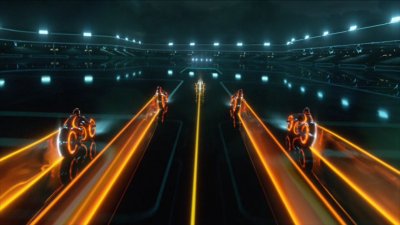
Motorcycles that leave streaks of colorful light which destroy other motorcycles? Forget the plot, this is why people come to see Tron.
Review by Jay Wilson Tron: Legacy is something of a paradox. The original 1982 film was so far ahead of its time that it took over twenty years for the effects to catch up with and do justice to its vision. The problem? How many sequels made, let’s say, ten years after the original are any good? What about sequels made twenty years later? Tron: Legacy comes almost thirty years later (twenty-eight, to be exact.) Fortunately, the sequel and the original both star Jeff Bridges which helps immeasurably to connect the two films. Like Stallone to Rambo, Schwartzenegger to The Terminator, and Harrison Ford to Indiana Jones, Jeff Bridges is essential to Tron. His presence alone gives the sequel an air of legitimacy that, strangely, no other actor could provide. He is Kevin Flynn, the man that got sucked into the computer and rode the Lightcycles (and Bridges being charming as hell in any role he takes on doesn’t hurt either.) Legacy starts magnificently enough, with vector lines slowly forming a top-down cityscape while Jeff Bridges explains “the grid” in voiceover. The vector lines form into a real city, the camera pans over and up to reveals the title while Daft Punk’s powerful score (a perfect blend of electronic/symphonic elements) swells majestically ... and immediately afterwards, the weight of this sequel’s unique circumstances begin to drag it down. 
A nice touch: twenty-eight years later, Bruce Boxleitner reprises his dual role as Alan Bradley/Tron.

Even today, the vision of Tron, its world, its vehicles, wardrobe, music, and architecture—its look and feel—is refreshingly unique and original.
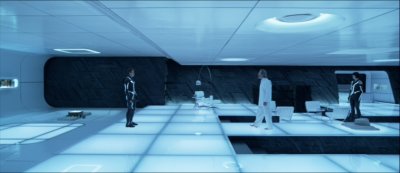
Even the interior sets have a nice slick, streamlined, futuristic look. I especially love the luminous quality in the floor panels floor and black and white color scheme (with a blue tint) to this interior.
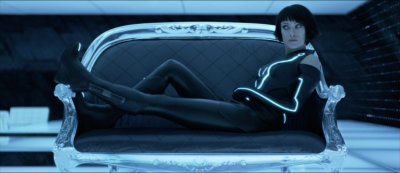
Of course, the Tron outfits give off their own circuit-board-shaped streaks of light. But also notice the reflective nature of the chair Quarra (Olivia Wilde) is sitting in, and how even the furniture seems to give off light.
We meet Kevin Flynn from 20 years ago as he tells his son a bedtime story based on his adventures in the first film, and in doing so he sets up some important plot points for this second film. Then we get the obligatory montage informing us Flynn went missing that very night; informing us where his company, Encom, went; and who gets custody of young Sam Flynn. Immediately after the montage, we have to meet grown up Sam as he rides his motorcycle through busy city streets evading a cop so later, when the Lightcycles show up, we know he’s in his element. From there, Sam breaks into Encom (even though technically it’s his company) and throws a nasty curve ball to the board meeting in progress. At the board meeting, they introduce us to Alan Bradley from the first film who is now something of a father figure to Sam. Next Bradley has to explain he got a page from a disconnected number that used to belong to Sam’s father. Then Sam has to investigate and stumble across the digitizing laser from the first movie which sucks him into the computer. You might look at the previous paragraph and think I just spoiled the whole movie. Let me assure you, dear reader, it’s mostly backstory. Some of it setup; most of it meaningless. Hollywood has a terrible habit of wanting to explain anything and everything that might conceivably require an explanation to a sub-standard representative to our species (aka studio executives). Anyway, as time passes between sequels, a gap develops that needs to be filled to preserve continuity between the two films. Legacy’s twenty-eight year wait left a canyon-sized gap and spends forever filling it in (and the explanation feels like a film unto itself.) But, I ask you, in the end ... do you really need to know who took care of Sam after his father disappeared? Do you really need to know who runs Encom now? Do you really need to see Sam parachute off the Encom building and run from the police? Do you really care knowing what’s coming? It’s a testament to the vision and imagination of the original that once Sam inevitably makes his way into the computer world how unique and visually interesting the frame becomes. The world of Tron draws inspiration, of course, from circuit patterns, replacing the conductive copper with luminous strips. Check out the wardrobe of Tron, the architecture, the cityscapes. Notice the streaks of light and pay attention to the patterns they form. When engineers built the first motherboard, they never dreamed those tiny copper pathways would one day help realize such a fantastic world. The vehicles of Tron pay tribute to the earliest generation of video games back when the hardware could only handle a laughable palette and a pathetic resolution which made the graphics look like blocky silhouettes. However, this limitation ironically lead to fantastic designs. Matt Groening of Simpsons and Futurama fame often states his theory of good cartoon design: that it be recognizable in silhouette. This is true, and it also applies to more than just cartoon characters. Think of Tron’s Recognizer, a flying ship shaped like a squared-up upside down U. That simple shape would feel right at home on an Atari 2600 screen, and it’s one of the most iconic ships in the Tron universe (and dare I say in all of cinematic Science Fiction.) The Lightcycles? Take a motorcycle, simplify it down to its most basic geometric shapes, and add a light streak behind it. 
I may not have liked Tron: Legacy, but I have to admit it does not suffer from a shortage of great images.
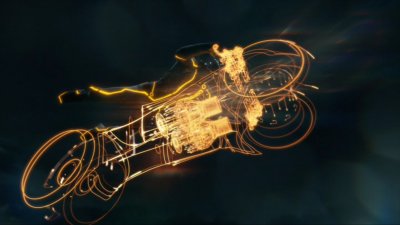
You may have noticed a lack of (clear) images of the protagonist, Sam Flynn (Garrett Hedlund). That’s no accident. Given the choice, I’d rather talk about and show another Lightcycle.
Going back to the circuitry motif, change “shape” to “pattern” and the Groening’s statement can apply to the strips of light which adorn everything in the Tron universe. Circuitry is a very distinct pattern of lines. Take those same lines, make them glow, and immediate people will think Tron. Combine the simplified-silhouette friendly shapes with the intricate yet distinct patterns of light, and is it any wonder you have one of the most memorable worlds ever dedicated to celluloid? I don’t like either Tron movie, but holy hell, do I ever adore their worlds. Legacy’s greatest strength is that it doesn’t fight the vision of the original movie. It admirably takes the original concept and preserves the intent while using today’s technology to present it in a way 1982’s computers could not. Now we can see the motor in the Lightcycles moving (and glowing), we can see the mechanical working of the Recognizer as it flies across a cloudy cityscape, but the original simple designs still prevail. While I love the shot composition and even the shot structure of Tron: Legacy, that same adoration doesn’t extend to how the film works as a whole. Take for example when Sam first mounts the iconic Lightcycle: running in slow motion, leaping into the air as the bike forms beneath him, landing on it fully formed, and taking off back in real time. Wonderful shot, but it feels isolated from the rest of the movie. The ensuing battle on the Lightcycles felt like I was looking at individual frames of a storyboard (and those frames look great, by the way), but the sequences cut mechanically from shot to shot in a curiously rehearsed and stale fashion when they should flow together seamlessly and organically. It’s not that Legacy is put together poorly. The individual shots work, and they work together to keep the action clear. There’s no question to basic spatial relationships and positions of the major players; Legacy communicates these things just fine. The thing is when I watch the canyon sequence in Star Wars, when I watch the T-800 rescue John Connor in Terminator 2, and when the giant boulder chases Indie in Raiders of the Lost Ark ... I’m there with the characters. Lucas, Spielberg, and Cameron bring me into the movie and make me live it with their characters. I came to Tron: Legacy with really only one expectation: to be exhilarated. I wanted to ride the Lightcycles ... but I didn’t. Whatever magic great directors infuse in their movies to make the action reach beyond the screen ... it just wasn’t there for Tron. 
Every kid in the 80s played “Tron” at least once while tossing a frisbee around with his friends. That’s right. Tron made frisbees cool. What did your sissy little sci-fi movie do?

Only this character played by this actor could get away with the line, “it's like digital jazz, man!”
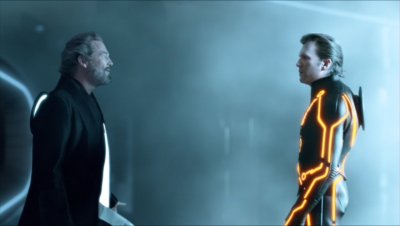
Something about Jeff Bridges being digitally made to look younger as the evil CLU doesn’t quite look right, but I’ll be damned if I can pinpoint what.
The music, though, that did work beautifully and did bring me to the Lightcycles, even though the film, itself, did not. Roger Ebert said it best, “the soundtrack by Daft Punk has such urgent electronic force that the visuals sometimes almost play as its accompaniment.” The whole score is simple, often relying on energetic rhythms that repeat. Oftentimes the music sounds like nothing more than layers of rhythms on top of each other. You see, many early video games (and some even to this day) featured short simplistic music cues that repeat infinitely. The almost mechanical repetition that would hurt any other score, is one-hundred percent appropriate in Tron. And even though Daft Punk walk close to disaster with said repetitions, they provide just enough variation to keep these rhythms and pulsation from becoming stale, boring, or monotonous. And Jeff bridges. How can you not like Jeff Bridges? He plays the dual role as Kevin Flynn, once again trapped inside the computer, and CLU, a computer program whose hard uncompromising logic has undermined his benign intentions. Flynn built CLU to build the perfect world, and now CLU seeks to eradicate imperfections. Both characters are painfully cliché. CLU like any cut-and-paste villain eliminates anything and everything that fails him or becomes unnecessary (of, I dunno, if he gets bored?); Flynn oscillates between wise old mentor with mastery over this digital world and young hippie spirit, yeah man! Were it not for Bridges’ on screen presence I would hate these characters. But that’s not surprising. Some people have magnetism. Others don’t. Likewise it’s not surprising the story and characters don’t stand up very well. The original Tron’s story and characters were flimsy pretext to deliver a spectacle; there was no reason to think the sequel would deliver anything different. I could go on and complain about specifics, but they didn’t bother me in the slightest. I didn’t rent Tron for the story. It’s all about the Lightcycles, baby. | ||||||||||||||||||||
|
| ||||||||||||||||||||
